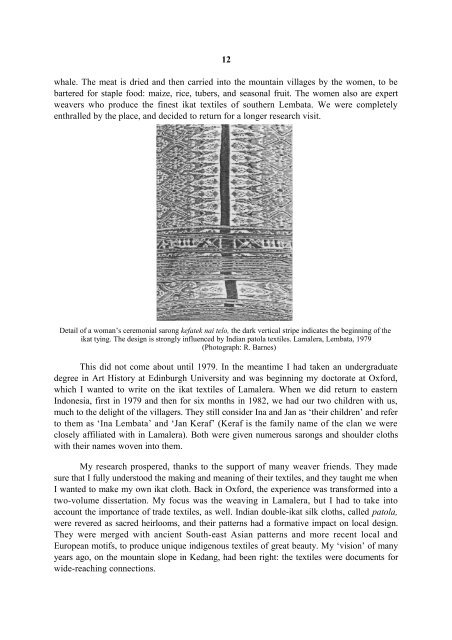download - OATG. Oxford Asian Textile Group
download - OATG. Oxford Asian Textile Group
download - OATG. Oxford Asian Textile Group
Create successful ePaper yourself
Turn your PDF publications into a flip-book with our unique Google optimized e-Paper software.
12<br />
whale. The meat is dried and then carried into the mountain villages by the women, to be<br />
bartered for staple food: maize, rice, tubers, and seasonal fruit. The women also are expert<br />
weavers who produce the finest ikat textiles of southern Lembata. We were completely<br />
enthralled by the place, and decided to return for a longer research visit.<br />
Detail of a woman’s ceremonial sarong kefatek nai telo, the dark vertical stripe indicates the beginning of the<br />
ikat tying. The design is strongly influenced by Indian patola textiles. Lamalera, Lembata, 1979<br />
(Photograph: R. Barnes)<br />
This did not come about until 1979. In the meantime I had taken an undergraduate<br />
degree in Art History at Edinburgh University and was beginning my doctorate at <strong>Oxford</strong>,<br />
which I wanted to write on the ikat textiles of Lamalera. When we did return to eastern<br />
Indonesia, first in 1979 and then for six months in 1982, we had our two children with us,<br />
much to the delight of the villagers. They still consider Ina and Jan as ‘their children’ and refer<br />
to them as ‘Ina Lembata’ and ‘Jan Keraf’ (Keraf is the family name of the clan we were<br />
closely affiliated with in Lamalera). Both were given numerous sarongs and shoulder cloths<br />
with their names woven into them.<br />
My research prospered, thanks to the support of many weaver friends. They made<br />
sure that I fully understood the making and meaning of their textiles, and they taught me when<br />
I wanted to make my own ikat cloth. Back in <strong>Oxford</strong>, the experience was transformed into a<br />
two-volume dissertation. My focus was the weaving in Lamalera, but I had to take into<br />
account the importance of trade textiles, as well. Indian double-ikat silk cloths, called patola,<br />
were revered as sacred heirlooms, and their patterns had a formative impact on local design.<br />
They were merged with ancient South-east <strong>Asian</strong> patterns and more recent local and<br />
European motifs, to produce unique indigenous textiles of great beauty. My ‘vision’ of many<br />
years ago, on the mountain slope in Kedang, had been right: the textiles were documents for<br />
wide-reaching connections.
















